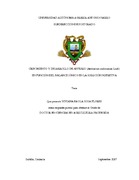Mostrar el registro sencillo del ítem
Crecimiento y desarrollo de anturío (Anthurium andreanum Lind.) en función del balance iónico en la solución nutritiva
| dc.contributor.advisor | Valdez Aguilar, Luis Alonso | |
| dc.contributor.author | Sosa Flores, Viviana Paola | |
| dc.contributor.other | Benavides Mendoza, Adalberto | |
| dc.contributor.other | Mendoza Villarreal, Rosalinda | |
| dc.contributor.other | Sandoval Rangel, Alberto | |
| dc.contributor.other | Juárez Maldonado, Antonio | |
| dc.date.accessioned | 2018-03-06T19:10:06Z | |
| dc.date.available | 2018-03-06T19:10:06Z | |
| dc.date.issued | 2017-09-06 | es_MX |
| dc.identifier.uri | http://repositorio.uaaan.mx:8080/xmlui/handle/123456789/43015 | |
| dc.description | Se Identifico las soluciones nutritivas que contengan un balance de cationes y aniones adecuado para el crecimiento y producción de flores de calidad de anturio en maceta. Determinar si el efecto de la aplicación de aniones y cationes resulta adecuado para el desarrollo de la planta y flores de anturio. | |
| dc.description.abstract | "El anturio (Anthurium andreanum Lind.) es una planta epífita sudamericana, valorada por su brillante colorido y por su espata y espádice de larga duración. Pertenece a la familia Araceae y es nativa de las zonas tropicales de Centro y Sur América. El nombre anturio se deriva de la palabra griega 'anthos' y 'oura' que significa cola en referencia a su inflorescencia (Mari, 2016). El comercio de anturios en EE.UU se valora alrededor de 50 millones de dólares y entre las flores cortadas tropicales ocupa el segundo lugar en importancia sólo después de las orquídeas. Los Países Bajos y Hawaii son los principales productores y Alemania, Italia, Japón, Francia y Estados Unidos son los principales consumidores (Murguia et al., 2002). En México, los anturios son cultivados desde hace cincuenta años, principalmente en el estado de Veracruz (Castillo, 2012), principalmente para la producción de flores de corte pero puede adecuarse a cultivos en maceta, es una planta habitualmente grande, de disposición relativamente abierta." | es_MX |
| dc.format | ||
| dc.language | Español | es_MX |
| dc.publisher | Universidad Autónoma Agraria Antonio Narro | |
| dc.rights | Acceso Abierto | |
| dc.rights.uri | CC BY-NC-ND - Atribución-NoComercial-SinDerivadas | |
| dc.subject | CIENCIAS AGROPECUARIAS Y BIOTECNOLOGÍA | es_MX |
| dc.subject.other | Planta | |
| dc.subject.other | Familia araceae | |
| dc.subject.other | Desarrollo | |
| dc.subject.other | Cultivo | |
| dc.title | Crecimiento y desarrollo de anturío (Anthurium andreanum Lind.) en función del balance iónico en la solución nutritiva | es_MX |
| dc.type | Tesis de doctorado | es_MX |
| dc.description.abstractEn | "The climatic conditions of the humid tropical areas of México allow the year-round production of cut flowers and potted plants of anthurium. However, there is scarce basic and applied research on tropical ornamental species, limiting the development of technology to increase their productivity and quality. The present study was designed to determine the effect of varying proportions of cations (K+, Ca+2, Mg+2) and anions (NO3 , H2PO4- and SO4-2) on the growth and nutrient status of potted anthurium plants. In this paper we are reporting the information as to the effect of the proportions of K+, Ca+2, Mg+2 in the nutrient solution on plant growth responses Using mixture analysis and response surface methodology. Response surface analysis detected that spathe and leaf areas decreased when fed with solutions of high proportions of Mg+2. Total shoot and root fresh weight, as well as total dry weight and root volume, also demonstrated the deleterious effects of high Mg+2 ratios. In general, considering all the parameters measured, the best growth of anthurium plants was obtained in two areas of the explored space; one area was high in Ca+2, with optimum ranges from 0.24 – 0.44 for K+, 0.54 – 0.68 for Ca+2, and 0.01 – 0.08 for Mg+2, and another area that was high in K+, on which the optimum ranges were 0.54 – 0.65 for K+, 0.25 – 0.29 for Ca+2, and 0.10 – 0.21 for Mg+2. Shoot and root K+, Ca+2 and Mg+2 concentration was significantly affected by the cation ratios, however, there was not a clear tendency as to the effect of each cation in the mixture; nonetheless, the internal K+ : Ca+2 : Mg+2 ratios were affected by the external ratios, as in the shoot they were located in a very specific area, indicating that anthurium plants accumulated more Mg+2 compared to what it is in the external solution, whereas Ca+2 ratio was lower than that of the external solution. As for K+, plants accumulated it at high rates regardless of the external balance. In conclusion, the optimum nutrient solutions for anthurium may contain very wide ratios of K+ as long Ca+2 and Mg+2 are maintained at low proportions." | |
| dc.type.version | Versión publicada | |
| dc.audience | Estudiantes | |
| dc.audience | Investigadores | |
| dc.publisher.place | Saltillo , Coahuila, México | es_MX |
| dc.type.thesis | Digital |
